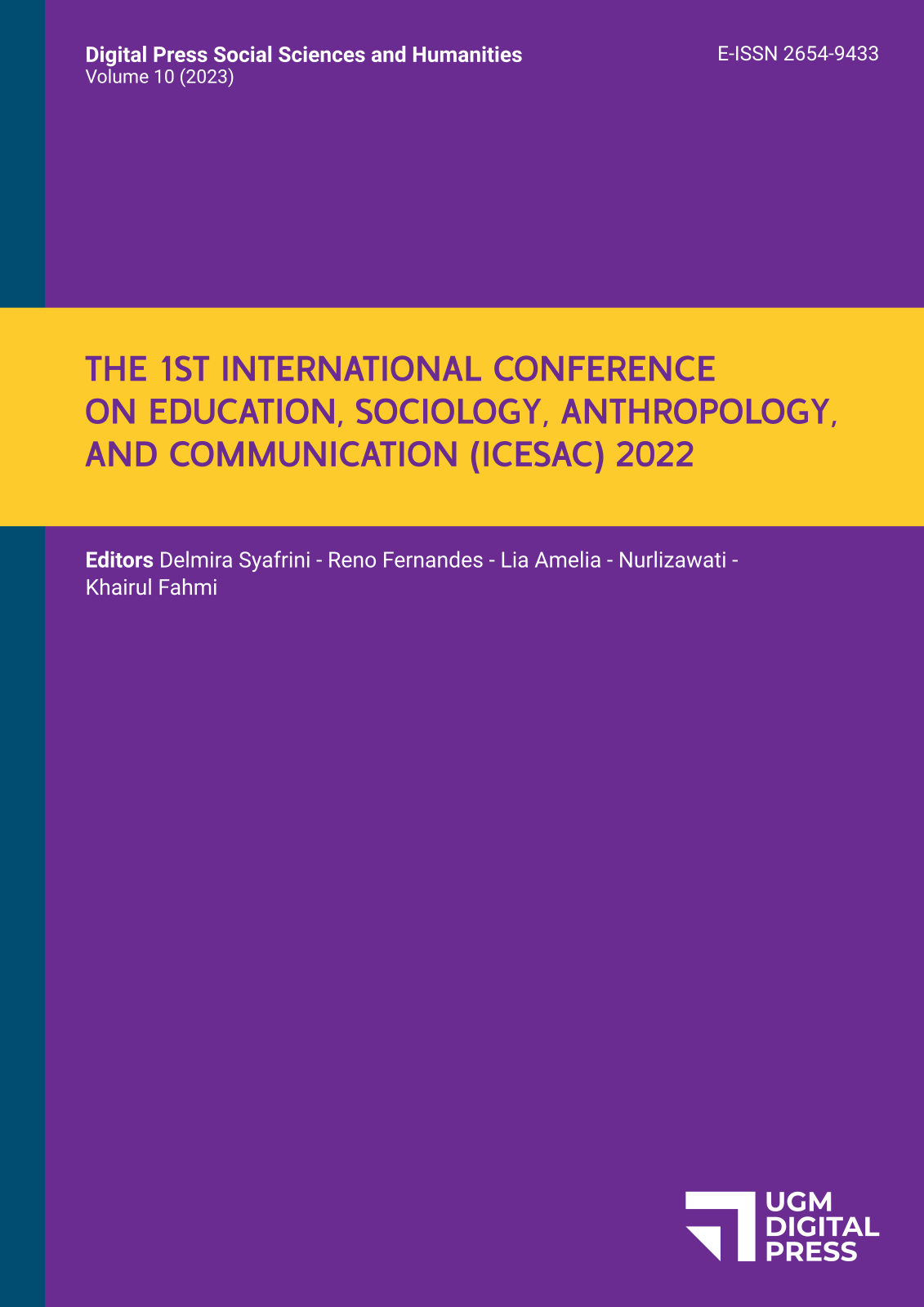The Potential of Komodo National Park in East Nusa Tenggara Province
Andi Oktami Dewi Artha Ayu Purnama
1
, Muhammad Ibrahim
2
, Apriliyanus Rakhmadi Pratama
3
1
Faculty of Ushuluddin and Da’wah, IAIN Sultan Amai Gorontalo, Gorontalo, Indonesia
2
Faculty of Education, Universitas Negeri Gorontalo, Gorontalo, Indonesia
3
Faculty of Tarbiyah and Education, IAN Sultan Amai Gorontalo, Gorontalo, Indonesia
oktamidewi@iaingorontalo.ac.id
Abstract
Komodo National Park is a natural tourist destination that act as a magnet tourism for local and foreign tourists in East Nusa Tenggara Province. Referred as one of Wonders of world not only because of the presence of the ancient Komodo dragon but also supported by its beautiful underwater scenery. The study aims to uncover the extension of Komodo National Park's role and contribution to regional development, as well as its obstacles on tourism development using qualitative research methods with a descriptive approach. The results indicate that Komodo National Park has high possibility in increasing regional income and the development of East Nusa Tenggara, there are also several other potential destinations but not only have not been managed optimally but also has its own policies to do not involve the local community in managing tourist destinations. Furthermore, in practice of tourism the authorities must also pay close attention to the principles of local community participation, local cultural rights, aspects of resource conservation, education and training, promotion, and monitoring and evaluation.
Keywords
komodo national park, Potential, tourism
References
Hironimus, Y. S., Rijanta, R., & Iskandar, D. A. (2019). Faktor-faktor yang mempengatuhi peran aktivitas pariwisata di Taman Nasional Komodo terhadap pertumbuhan ekonomi wilayah Kabupaten Manggarai Barat. Region: Jurnal Pembangunan Wilayah Dan Perencanaan Partisipatif, 14(2), 141–153.
Imur, N., & Junaeda, S. (2022). Pengembangan Etno-Ecotourism pada Taman Nasional Komodo Kabupaten Manggarai Barat. Jurnal Kajian Sosial Dan Budaya: Tebar Science, 6(3), 58–67. https://doi.org/10.36653/jksb.v6i3.129
Iriyono, S., Syari’fudin, M., Kurniawan, M., Adnan, A., Indriasari, D., Buaithi, A., & Margaretha, P. (2013). The Assessment of Komodo National Park’s Role in the Economics of West Manggarai Regency Nusa Tenggara Timur Province (Development of Ecotourism Utilization Aspect Case Study). Labuan Bajo: Komodo National Park Office.
Kelang, M. S. (2010). Pengembangan Pariwisata Di Kabupaten Manggarai Barat Melalui Pembentukan Cluster Wisata (Thesis). Diponogoro University, Semarang, Indonesia.
Koentjaraningrat. (1994). Metode-Metode Penelitian Masyarakat. Jakarta, Indonesia: Gramedia Pustaka Utama.
Modestus Ziku, R. (2015). Partisipasi Masyarakat Desa Komodo dalam Pengembangan Ekowisata di Pulau Komodo. Jurnal Master Pariwisata (JUMPA). https://doi.org/10.24843/JUMPA.2015.v02.i01.p01
Osin, R., Rizky, I., Kusuma, I. R. W., & Suryawati, D. (2019). Strategi Pengembangan Objek Wisata Kampung Tradisional Bena Kabupaten Ngada-Flores Nusa Tenggara Timur (NTT). Jurnal Ekonomi Dan Pariwisata, 14(1).Putra, P. S. E., & Parno, R. (2018). Stategi Pengembangan Ekowisata Taman Nasional Komodo Di Desa Komodo Nusa Tenggara Timur. Prosiding Seminar Ilmiah Nasional Teknologi, Sains, Dan Sosial Humaniora, 1. Lembaga Penelitian dan Pengabdian Kepada Masyarakat Universitas Dhyana Pura.
Sarbaitinil. (2018). Partisipasi masyarakat daerah tujuan wisata dan implikasinya dalam pengembangan pariwisata. Jurnal Kepariwisataan Dan Hospitalitas, 2(2), 1–16. https://doi.org/10.24843/JKH.2018.v02.i02.p01
2 Faculty of Education, Universitas Negeri Gorontalo, Gorontalo, Indonesia
3 Faculty of Tarbiyah and Education, IAN Sultan Amai Gorontalo, Gorontalo, Indonesia
oktamidewi@iaingorontalo.ac.id
Abstract
Komodo National Park is a natural tourist destination that act as a magnet tourism for local and foreign tourists in East Nusa Tenggara Province. Referred as one of Wonders of world not only because of the presence of the ancient Komodo dragon but also supported by its beautiful underwater scenery. The study aims to uncover the extension of Komodo National Park's role and contribution to regional development, as well as its obstacles on tourism development using qualitative research methods with a descriptive approach. The results indicate that Komodo National Park has high possibility in increasing regional income and the development of East Nusa Tenggara, there are also several other potential destinations but not only have not been managed optimally but also has its own policies to do not involve the local community in managing tourist destinations. Furthermore, in practice of tourism the authorities must also pay close attention to the principles of local community participation, local cultural rights, aspects of resource conservation, education and training, promotion, and monitoring and evaluation.Keywords
komodo national park, Potential, tourismReferences
Hironimus, Y. S., Rijanta, R., & Iskandar, D. A. (2019). Faktor-faktor yang mempengatuhi peran aktivitas pariwisata di Taman Nasional Komodo terhadap pertumbuhan ekonomi wilayah Kabupaten Manggarai Barat. Region: Jurnal Pembangunan Wilayah Dan Perencanaan Partisipatif, 14(2), 141–153.
Imur, N., & Junaeda, S. (2022). Pengembangan Etno-Ecotourism pada Taman Nasional Komodo Kabupaten Manggarai Barat. Jurnal Kajian Sosial Dan Budaya: Tebar Science, 6(3), 58–67. https://doi.org/10.36653/jksb.v6i3.129
Iriyono, S., Syari’fudin, M., Kurniawan, M., Adnan, A., Indriasari, D., Buaithi, A., & Margaretha, P. (2013). The Assessment of Komodo National Park’s Role in the Economics of West Manggarai Regency Nusa Tenggara Timur Province (Development of Ecotourism Utilization Aspect Case Study). Labuan Bajo: Komodo National Park Office.
Kelang, M. S. (2010). Pengembangan Pariwisata Di Kabupaten Manggarai Barat Melalui Pembentukan Cluster Wisata (Thesis). Diponogoro University, Semarang, Indonesia.
Koentjaraningrat. (1994). Metode-Metode Penelitian Masyarakat. Jakarta, Indonesia: Gramedia Pustaka Utama.
Modestus Ziku, R. (2015). Partisipasi Masyarakat Desa Komodo dalam Pengembangan Ekowisata di Pulau Komodo. Jurnal Master Pariwisata (JUMPA). https://doi.org/10.24843/JUMPA.2015.v02.i01.p01
Osin, R., Rizky, I., Kusuma, I. R. W., & Suryawati, D. (2019). Strategi Pengembangan Objek Wisata Kampung Tradisional Bena Kabupaten Ngada-Flores Nusa Tenggara Timur (NTT). Jurnal Ekonomi Dan Pariwisata, 14(1).
Putra, P. S. E., & Parno, R. (2018). Stategi Pengembangan Ekowisata Taman Nasional Komodo Di Desa Komodo Nusa Tenggara Timur. Prosiding Seminar Ilmiah Nasional Teknologi, Sains, Dan Sosial Humaniora, 1. Lembaga Penelitian dan Pengabdian Kepada Masyarakat Universitas Dhyana Pura.
Sarbaitinil. (2018). Partisipasi masyarakat daerah tujuan wisata dan implikasinya dalam pengembangan pariwisata. Jurnal Kepariwisataan Dan Hospitalitas, 2(2), 1–16. https://doi.org/10.24843/JKH.2018.v02.i02.p01

